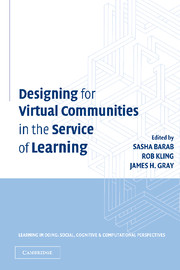Book contents
- Frontmatter
- Contents
- List of Contributors
- Series Foreword
- Foreword
- Preface and Acknowledgments
- In Memoriam
- PART I COMING TO TERMS WITH COMMUNITY
- PART II DESIGNING FOR WEB-SUPPORTED COMMUNITY
- 3 Designing System Dualities
- 4 Group Behavior and Learning in Electronic Forums
- 5 Teacher Professional Development, Technology, and Communities of Practice
- 6 Community of Practice
- PART III FOSTERING COMMUNITY/MEMBER PARTICIPATION
- PART IV RESEARCHING ONLINE COMMUNITY
- Index
- Titles in the series
- References
6 - Community of Practice
A Metaphor for Online Design?
Published online by Cambridge University Press: 05 June 2012
- Frontmatter
- Contents
- List of Contributors
- Series Foreword
- Foreword
- Preface and Acknowledgments
- In Memoriam
- PART I COMING TO TERMS WITH COMMUNITY
- PART II DESIGNING FOR WEB-SUPPORTED COMMUNITY
- 3 Designing System Dualities
- 4 Group Behavior and Learning in Electronic Forums
- 5 Teacher Professional Development, Technology, and Communities of Practice
- 6 Community of Practice
- PART III FOSTERING COMMUNITY/MEMBER PARTICIPATION
- PART IV RESEARCHING ONLINE COMMUNITY
- Index
- Titles in the series
- References
Summary
The field of Instructional Technology has a long tradition of design to support learning, using both soft technology (e.g., coaching or mentoring) and hard technology (e.g., computer-assisted instruction). A new commercial communications technology is released in the marketplace, and then within a few years the scholarly journals develop a series of claims, and some preliminary data, about the potential for teaching and learning. Current enthusiasm that a community of practice (CoP) would be a compelling tool to support learning in organizations is well beyond empirical evidence and is inconsistent with related theory for nurturing CoPs. The major assumption of this chapter is that there is a historic tautology in the field of educational technology that is extremely seductive and persistent. The major thesis is: the enthusiasm for online communities seems premature in the sense that the technology is the natural vehicle for CoPs.
The readers of this volume are certainly well acquainted with Lave and Wenger's (1991) and Wenger's (1998) seminal work on communities of practice. One can reasonably credit the authors with dramatically influencing both research and development efforts in an extremely wide variety of contexts. Legitimate peripheral participation in a community of practice is a compelling and relatively fresh theoretical approach to the complicated pattern of workplace learning and related identity formation. Caught up in this enthusiasm, several of the first author's students have conducted case studies examining professional business consultants, engineers, and defense lawyers.
- Type
- Chapter
- Information
- Designing for Virtual Communities in the Service of Learning , pp. 154 - 178Publisher: Cambridge University PressPrint publication year: 2004
References
- 26
- Cited by



